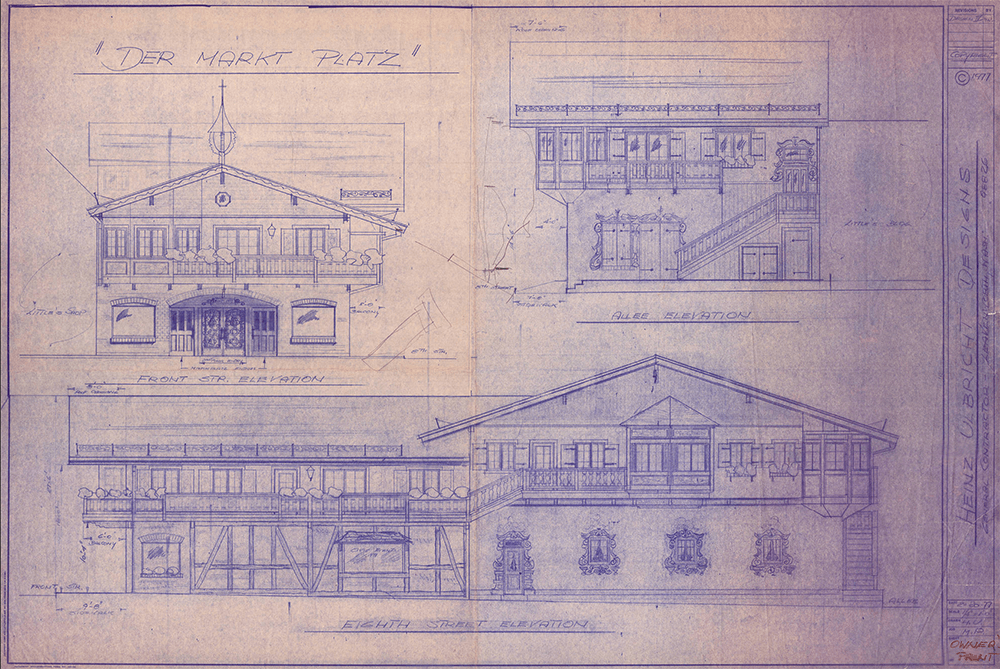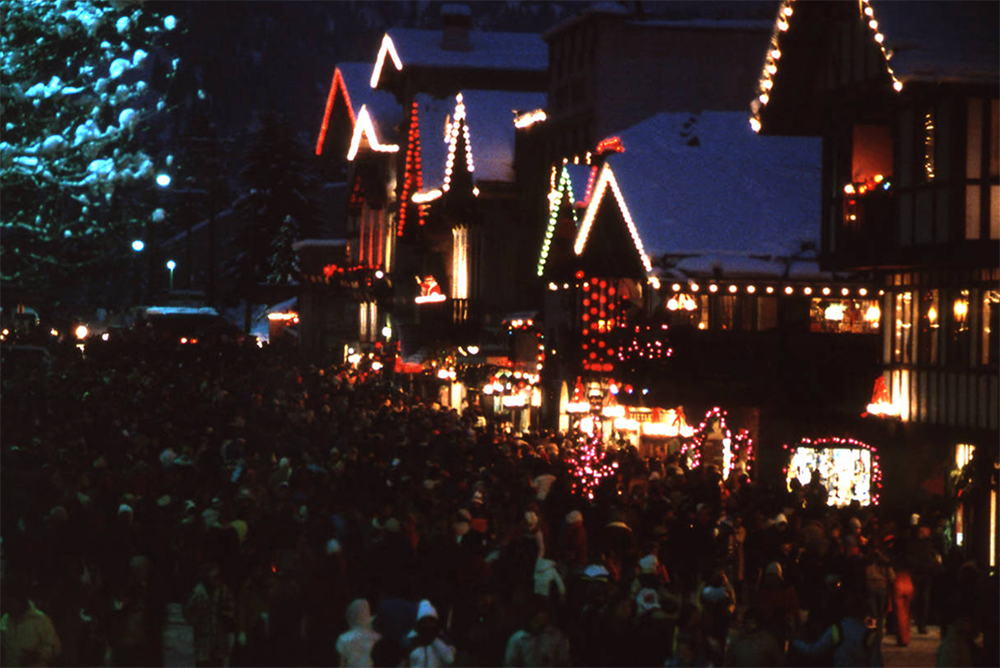The Story of the Transformation of Leavenworth, Washington
In 1960 Ted Price and Bob Rodgers purchased the Coles Corner Café in the Cascade Mountains near Leavenworth, Washington. When they remodeled the restaurant, Price wanted a Native American theme. Rodgers, who had been to Bavaria and saw the resemblance of the Cascade landscape, pushed for a Bavarian theme; luckily for Leavenworth, the Bavarian theme won out. They renamed the restaurant The Squirrel Tree and incorporated many Bavarian features, including dirndls worn by the waitresses, music, flowers, Christmas lighting, and decorative architectural elements. The restaurant was an immediate success, so in 1961 they built The Squirrel Tree Chalet Motel, the first Bavarian-style structure in the Pacific Northwest
Ted and Bob next planned to create an authentic "Old Bavarian Village" adjoining the restaurant and motel, but this undertaking proved unfeasible. Ted then became active in the business affairs of nearby Leavenworth, then suffering a severe economic depression. In order to save their town, under the guidance of the University of Washington, the Leavenworth townspeople had undertaken an extensive self-help study project, called "Leavenworth Improvement For Everyone" or Project LIFE.
Ted joined with other business people, and in 1963 he proposed and became chairman of the LIFE Tourism Committee. When Price and Rodgers first advanced the idea of a theme town based on tourism and the adoption of the Bavarian village motif, as outsiders they were working with a double handicap; not only were they originally from Seattle, but their current Squirrel Tree business and home were outside of town.
Price and Rodgers decided to sell the Squirrel Tree and acquire as much Leavenworth property as possible with an eye to remodeling it in Bavarian style. Even after they moved into town, the prejudice persisted, possibly fueled also by their status as bachelor friends rather than family men. Many years later, in 1986, the two partners left Leavenworth and retired to Palm Springs, California. They did not come out as a gay couple until years after their departure from Leavenworth, but suspicions and prejudices may have existed during their time there. Price and Rodgers continued to push for their idea. Some major property owners soon took out loans in order to transform their own buildings, but the question remained of how to proceed with the actual remodeling. Fortunately for Leavenworth, Earl Petersen, the designer of Solvang, the Danish-themed town in California, contacted Ted Price to offer his services. Petersen and another designer with Old World-style experience, German-born Heinz Ulbricht of Seattle, guided the remodeling to ensure the utmost authenticity. Ulbricht and his family later moved to Leavenworth.
On March 21, 1968, Leavenworth was one of 11 cities to receive an All America City Award from Look magazine and the National Municipal League. According to the Leavenworth Echo, Leavenworth was "honored for pulling itself out of a serious economic slump."
Another "outsider" who became a benefactor of Leavenworth was Carolyn Schutte (d. 1975). Carolyn often brought guests to the Squirrel Tree and had befriended Price and Rodgers. Over several years, she purchased property in Leavenworth, including part of the riverfront that would eventually become Riverfront Park. One of the holdouts against the Bavarian village idea had been Robert B. Field (d. 1967), a longtime banker who had arrived in Leavenworth in 1910. In 1968 Carolyn Schutte bought Field’s home and the adjoining half mile of riverfront property, which had been his Bent River Arabian Horse Ranch. At her suggestion, Price and Rodgers moved into the house and bought it from her a few years later. In 1972, Schutte deeded the valuable river frontage property to the city of Leavenworth. A substantial portion of what is now Riverfront Park is the result of this gift. The Field home later became the Haus Lorelei Bed and Breakfast and now houses the Upper Valley Museum.
In order to ensure continuing authenticity, the town created the Leavenworth Design Review Board, which became official on July 16, 1970. All construction and remodeling in Leavenworth must meet not only the usual codes but also the Bavarian styles stipulated by this board. Although the remodeling of privately owned buildings was achieved without any government money, the city did take advantage of public grants to acquire and develop waterfront property for the park and recreational purposes. The Washington State Inter-Agency Committee for Outdoor Recreation (IAC) provided communities with matching funds for these purposes. Because the federal government then matched both city and state funds, the community only had to raise 25 percent of the total. In addition, Carolyn Schutte donated her property along the river and Price and Rodgers bought five waterfront acres across the river to donate.
It wasn’t long before tourists began flocking to Leavenworth, attracted not only by the scenery, recreational opportunities, shopping, and European flavor of the place, but by special events and festivals. The normal population of around 2,500 can grow to 10 times that on holiday weekends, when dozens of tour buses empty their passengers onto the main streets. Approximately three million tourists visit Leavenworth every year, and the sales taxes that their purchases generate benefit the state coffers. Each season has its festival (or more than one): the Autumn Leaf Festival, Oktoberfest, the Village Lighting Festival, the Bavarian Ice Fest, Maifest, yodeling and accordion festivals, wine tastings, and a host of other events bring large numbers of tourists to the once dying town








